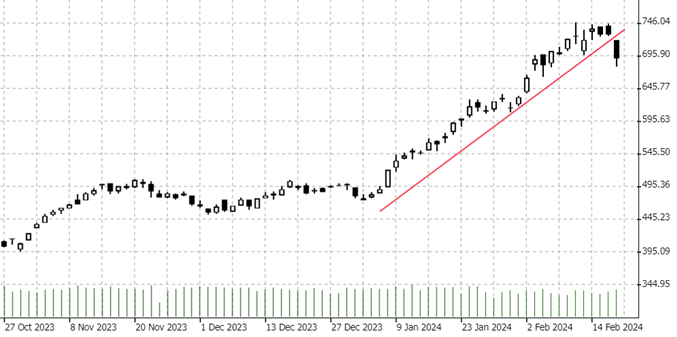

21.02.2024 – All eyes on Wall Street are on Nvidia. The share is one of the Magnificent Seven that has contributed significantly to the bull run on the Nasdaq. If the exorbitantly high expectations are not met, the stock and the entire high-tech market are threatened by a price avalanche.
Top or bottom – we will know more after the close of trading today, Wednesday. The share has recently crumbled. In any case, the daily chart does not look good for the bulls – but perhaps this is a bear trap.

Source: Bernstein Bank GmbH
So will the chip manufacturer, which is benefiting from the boom in artificial intelligence, continue to correct? The financial blog “Newsquawk” reported that the consensus on Wall Street is that Nvidia will have to massively exceed expectations in order to maintain momentum – “or we are likely to see another post-earnings period of consolidation akin to what has been seen in recent quarters – the price action Tuesday reflects some front-running of those concerns.”
Mega-high expectations
According to “Finanzen.net”, 37 analysts expect an average profit of USD 4.59 per share for the latest quarter. This compares to 88 cents a year earlier. A further 38 analysts expect turnover of USD 20.4 billion for the past quarter. This would be an increase of around 237 per cent compared to the same period last year.
Looking at the past financial year, 42 analysts see earnings of 12.39 dollars per share. According to “Finanzen.net”, this compares to USD 1.76 in the previous financial year. Furthermore, 47 analysts see an average turnover of 59.26 billion, compared to 26.97 billion dollars in the previous year.
So these are the benchmarks. And of course the outlook in the analyst call. If Nvidia touches or even breaks just one of these bars, things will get exciting on the stock market. Palo Alto has just sent out a warning in this direction: The cybersecurity company cut its revenue forecast and warned of a fatigue in IT security spending. As a result, the share easily lost a fifth of its value.
Overcrowding and a possible turning point
The problem with the whole thing is that many people are still long Nvidia. Who should still buy? At the very least, profit-taking is quite possible. With this in mind, several Goldman Sachs traders have recently spoken out. Goldman trader Bobby Molavi said that two years ago, the energy sector in the S&P 500 was five times heavier than Nvidia. Today, Nvidia is valued higher than all energy stocks combined.
The flow analysts, who keep an eye on money flows, also said: “Everyone’s in the pool”. And further: Wall Street has ignored the hot consumer prices, the long duration of the lockdown, the increasing geopolitical risks and the rising yields. We add: The upcoming Federal Reserve minutes could also provide a trigger for an exit.
Nvidia’s figures could therefore mark the turning point on the markets, said investment strategist Charles-Henry Monchau from the Geneva-based private bank Syz in an interview with Bloomberg TV. This is because the direction of the stock markets depends heavily on the performance of some tech heavyweights such as Nvidia. So we are curious to see what will happen. Whether long or short – Bernstein Bank wishes you successful trades and investments!
_________________________________________________________________________________________________________________________________________
The content of this publication is for general information purposes only. In this context, it is neither an individual investment recommendation or advice nor an offer to purchase or sell securities or other financial products. The content in question and all the information contained therein do not in any way replace individual investor- or investment-oriented advice. No reliable forecast or indication for the future is possible with respect to any presentation or information on the present or past performance of the relevant underlying assets. All information and data presented in this publication are based on reliable sources. However, Bernstein Bank does not guarantee that the information and data contained in this publication is up-to-date, correct and complete. Securities traded on the financial markets are subject to price fluctuations. A contract for difference (CFD) is also a financial instrument with leverage effect. Against this backdrop, CFD trading involves a high risk up to the point of total loss and may not be suitable for all investors. Therefore, make sure that you have fully understood all the correlating risks. If necessary, ask for independent advice. CFDs are complex instruments and are associated with the high risk of losing money quickly because of the leverage effect. 68% of retail investor accounts lose money trading CFD with this provider. You should consider whether you understand how CFD work and whether you can afford to take the high risk of losing your money.7
